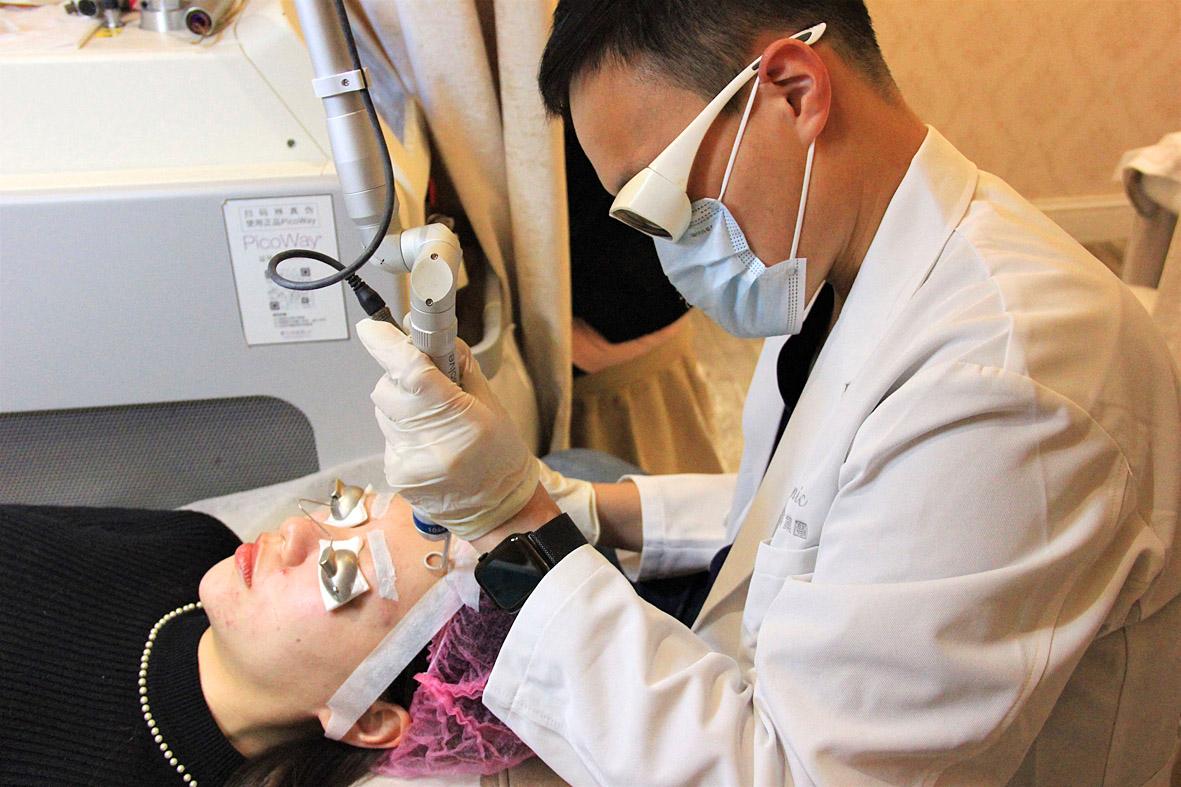Women who are operated on by a male surgeon are much more likely to die, experience complications and be readmitted to hospital than when a woman performs the procedure, research reveals.
Women are 15 percent more liable to suffer a bad outcome, and 32 percent more likely to die, when a man rather than a woman carries out the surgery, according to a study of 1.3 million patients.
The findings have sparked a debate about the fact that surgery in the UK remains a hugely male-dominated area of medicine and claims that “implicit sex biases” among male surgeons may help explain why women are at such greater risk when they have an operation.

Photo: AFP
“In our 1.3 million patient sample involving nearly 3,000 surgeons we found that female patients treated by male surgeons had 15 percent greater odds of worse outcomes than female patients treated by female surgeons,” said Angela Jerath, an associate professor and clinical epidemiologist at the University of Toronto in Canada and a co-author of the findings.
“This result has real-world medical consequences for female patients and manifests itself in more complications, readmissions to hospital and death for females compared with males,” she said. “We have demonstrated in our paper that we are failing some female patients and that some are unnecessarily falling through the cracks with adverse, and sometimes fatal, consequences.”
The findings have been published in the medical journal JAMA Surgery.
Jerath added: “These results are concerning because there should be no sex difference in patient outcomes regardless of the surgeon’s sex. On a macro level the results are troubling. When a female surgeon operates, patient outcomes are generally better, particularly for women, even after adjusting for differences in chronic health status, age and other factors, when undergoing the same procedures.”
Jerath and her colleagues analyzed the records of 1,320,108 patients in Ontario who underwent 21 common surgical procedures performed by 2,937 surgeons between 2007 and 2019. They ranged from hip and knee replacements and weight loss surgery to removal of an appendix or gall bladder and more complicated operations such as a heart bypass, aneurysm repair and brain surgery.
For each of the 1.3 million operations they analyzed, the sex of each patient and details of how their procedure had gone and also the sex of the surgeon who carried it out.
They found that men who had an operation had the same outcomes regardless of whether their surgeon was male or female. However, women experienced better outcomes if the procedure had been performed by a female surgeon compared with a male surgeon. There were no gender differences in how surgery went for either men or women operated on by a female surgeon.
Jerath added that while “there are some excellent male surgeons who consistently have good outcomes, what is concerning is that this analysis does signal some real difference among male and female surgeons overall where practice can impact general patient outcomes.”
FIRST OF ITS KIND STUDY
The researchers said the study was the first of its kind to examine the association between the sex of the patient, the sex of their surgeon and the outcomes of surgery. They looked at three types of “adverse postoperative outcome:” death, readmission to hospital and complications within 30 days.
They found that for women, treatment by a male surgeon was associated with a 15 percent increased likelihood of a poor outcome than if they were treated by a female surgeon. However, men experienced no differences whether they were treated by a male or female surgeon.
Similarly, women who were operated on by a male surgeon had a 32 percent higher risk of death than those whose surgery had been performed by a woman. For example, while 1.4 percent of women who had a cardiothoracic operation with a male surgeon died, fewer — 1 percent — did so when a female surgeon was involved. In both brain surgery and vascular surgery, while 1.2 percent of women who underwent either type of operation with a male surgeon died, again that proportion was much lower among those whose surgeon was female — 0.9 percent — giving a 33 percent higher risk of death.
Overall, female patients also had a 16 percent greater risk of complications and an 11 percent greater risk of readmission and were 20 percent more likely to have to stay in hospital longer.
Women had a higher risk of death, readmission or complications when a man performed the operation across many of the 21 types of surgery analyzed.
For example, while 20.2 percent of women who had cardiothoracic (chest) surgery by a male surgeon suffered some form of adverse reaction, a lower percentage — 18 percent — did so if their surgeon was female. The same pattern was seen in general surgery, brain surgery and orthopaedic surgery.
Technical differences between male and female surgeons are unlikely to explain the findings “as both sexes undergo the same technical medical training,” Jerath said.
“Implicit sex biases,” in which surgeons “act on subconscious, deeply ingrained biases, stereotypes and attitudes,” may be one possible explanation, she said. Differences in men’s and women’s communication and interpersonal skills evident in surgeons’ discussions with patients before the operation takes place may also be a factor, she added. And “differences between male and female physician work style, decision-making and judgment.”
Fiona Myint, the vice-president of the Royal College of Surgeons of England, highlighted that 86 percent of consultant (senior) surgeons in Britain were men.
“Surgery is still a long way from having a gender balance in its workforce. Women make up 41 percent of early stage surgeons but only 30 percent of higher trainees and 14 percent of consultants,” she said. Parenthood, “a lack of flexibility in [surgical] training schedules and rotas” and “negative attitudes to less than full-time training” all explain why many women do not become consultant surgeons, she added.
Scarlett McNally, who has been a consultant orthopedic surgeon for 20 years, said there was “increasing evidence of a different experience for women surgeons, with many being put off surgery and reporting historical ‘microaggressions.’” In addition, female patients may feel more at ease talking to a female surgeon before the operation, including steps they should take to improve their chances of a good outcome, such as stopping smoking to help ensure a bone graft takes, she added.
McNally also cited “unconscious bias” — assumptions among senior surgeons, nurses, administrators and patients that female medical students or young doctors will not want to pursue a career in surgery — as a factor.
“Having more female surgeons would improve all patients’ outcomes,” she said.

May 18 to May 24 Pastor Yang Hsu’s (楊煦) congregation was shocked upon seeing the land he chose to build his orphanage. It was surrounded by mountains on three sides, and the only way to access it was to cross a river by foot. The soil was poor due to runoff, and large rocks strewn across the plot prevented much from growing. In addition, there was no running water or electricity. But it was all Yang could afford. He and his Indigenous Atayal wife Lin Feng-ying (林鳳英) had already been caring for 24 orphans in their home, and they were in

On May 2, Chinese Nationalist Party (KMT) Chairman Eric Chu (朱立倫), at a meeting in support of Taipei city councilors at party headquarters, compared President William Lai (賴清德) to Hitler. Chu claimed that unlike any other democracy worldwide in history, no other leader was rooting out opposing parties like Lai and the Democratic Progressive Party (DPP). That his statements are wildly inaccurate was not the point. It was a rallying cry, not a history lesson. This was intentional to provoke the international diplomatic community into a response, which was promptly provided. Both the German and Israeli offices issued statements on Facebook

Even by the standards of Ukraine’s International Legion, which comprises volunteers from over 55 countries, Han has an unusual backstory. Born in Taichung, he grew up in Costa Rica — then one of Taiwan’s diplomatic allies — where a relative worked for the embassy. After attending an American international high school in San Jose, Costa Rica’s capital, Han — who prefers to use only his given name for OPSEC (operations security) reasons — moved to the US in his teens. He attended Penn State University before returning to Taiwan to work in the semiconductor industry in Kaohsiung, where he

Australia’s ABC last week published a piece on the recall campaign. The article emphasized the divisions in Taiwanese society and blamed the recall for worsening them. It quotes a supporter of the Taiwan People’s Party (TPP) as saying “I’m 43 years old, born and raised here, and I’ve never seen the country this divided in my entire life.” Apparently, as an adult, she slept through the post-election violence in 2000 and 2004 by the Chinese Nationalist Party (KMT), the veiled coup threats by the military when Chen Shui-bian (陳水扁) became president, the 2006 Red Shirt protests against him ginned up by